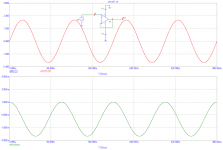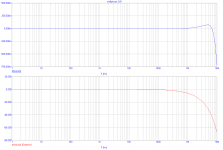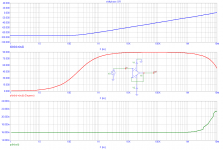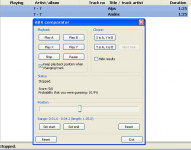But please let me show you that the case might not be that straightforward. Even in case of 'visually' low phase shift the difference signal is not negligible and will be easily visible in logarithmic dB scale (FFT). Image attached.
Attachments
Last edited:
You can see the amplitude and phase response of the difference v(in) - v(out) in the attached image. It may be surprising that it is caused only by group delay of 16ns. But it is logical, depends on ratio of group delay and half-period of sinusoidal signal.
Attachments
You told me enough about your test yesterday. It would be high above my abilities to find out everything exactly.
As there have been no more comments on this test today I think its probably time to call time on it and reveal exactly what you were listening too.
Alps was the direct feed into the A/D convertor.
Andes was the signal passing through five NE5532's each configured as a unity gain buffer, the output of each feeding direct into the input of the next. The output of the 5th opamp was fed to the A/D convertor. One listener reported that this was the preferred version in that it seemed to have more musical content compared with Alps.
This was a very important test to me because there is much discussion and feeling that even unity gain stable opamps are running right up to the point of "instability" when used with 100% feedback. Some designers suggest that throwing away a little gain (increasing the noise gain) can have benefits to sonics. So it was of interest to me to see what the reality might be with the classic unity gain follower. The scope shot in post #18 shows the curious effect that occurs when the 5532 is fed a fast slewing input signal however nothing in music approaches those speeds. It is easily fixed by adding a small R/C input filter but many designs don't do that and so I wanted to see (or hear) it worst case.
The other question mark over bjt input opamps, and particularly the 5532, is that they can misbehave when fed with hf noise, and as this test track was straight from an SACD that situation arises. SACD players can have (relatively) high levels of hf noise on the audio output. This could be one possible reason that 5532 gets a poor reception generally because its commonly used as an I/V convertor/filter in many CD players, possibly a role to which it isn't best suited.
So thanks to all that took part, and I hope we all can take something away from these tests. It has certainly been very interesting to me.
Alps have had distinctively better hi hats. No one else than me has posted a valid ABX result, I would say
NE5532 is not my favorite, frankly speaking.
Indeed
What would be your own recommend for a unity gain stable opamp ?
That was me ... I dips me lid to Pavel, good ears there! Just relistening, I can now pick how Pavel picked it, and also why I chose Andes. If one uses equipment which is less than optimum, which is certainly the case for what I have, the combination of the characteristics of the track and the equipment tune will be such that certain sounds will be conveyed better. So, for me, even now the combination of voice and piano work "better" over the NE5532 path, the greater "correctness" of the direct path registers less, subjectively. But, noting Pavel's comments about the hi-hat I can now hear the better rendition of the latter in the direct path, the couple of times when it's struck ...One listener reported that this was the preferred version in that it seemed to have more musical content compared with Alps
And, finally gave foobar2000 and ABX a go, and I'm even more impressed by the good results people have got so far! Tried Alpes and Andes, got 2/3, but the overall sound was starting to bug me - so, switched back to Nero, what a breath of fresh air!! Unfortunately, for me, foobar and the ABX combo slug the sound quality badly, a deadness is added to the sound which makes the process very uninspiring - the difference between foobar/ABX and Nero is far greater than the difference between Alpes and Andes ...
That's fine, but even possible DC coupled hardware circuit will introduce frequency dependent phase shifts due to its own high frequency roll-off. This is to explain the difference spectrum. Regarding audibility, I am not sure, but probably a combination of both linear and non-linear distortions makes the audible discernible (though not easily) difference.
How is the difference spectrum being generated? File alignments indicate time base mismatch.
Would you show a difference spectrum?
If these are DC coupled circuits, how has impulse response been measured?
Data?
Here is an ABX result for Alps v Andes:
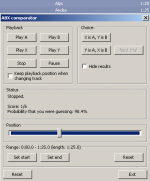
Probability that I was guessing of 98.4%? Riding the horse facing backwards.
And, finally gave foobar2000 and ABX a go, and I'm even more impressed by the good results people have got so far! Tried Alpes and Andes, got 2/3, but the overall sound was starting to bug me - so, switched back to Nero, what a breath of fresh air!! Unfortunately, for me, foobar and the ABX combo slug the sound quality badly, a deadness is added to the sound which makes the process very uninspiring - the difference between foobar/ABX and Nero is far greater than the difference between Alpes and Andes ...
Interesting to read... and I've no answer to that.
My limited experience with foobar shows that it depends on how Media Player was last set at. For example if I turn the graphic eq on and alter it in Media Player and then close MP and open foobar, it is the MP settings that I hear.
Could Nero have some eq or settings of its own that are remembered independently of MP ? Just a guess
I do everything to minimise dynamic processing, but Windows is a slippery fellow - no guarantees that all bases are covered! I have tried foobar several times over a year or so ... but every time it's always come out as a ... Naaah!!My limited experience with foobar shows that it depends on how Media Player was last set at. For example if I turn the graphic eq on and alter it in Media Player and then close MP and open foobar, it is the MP settings that I hear.
Could Nero have some eq or settings of its own that are remembered independently of MP ? Just a guess
What is a poor feature with the ABX is that it is dynamically updating the display while playing - this is not a smart thing to do ...!
I work with XP, never activated any EQ or another audio nonsense and have had no problems with foobar. I always test D/A - AD chain with a set of test tones and FFT analysis. Playback with foobar, signal capture by Arta or CE. Then I know what the playback is really doing. Even a freeware Rightmark test will tell you if your audio setting is OK or not. One must not rely on listening only - your results might be wrong then. Too many variables.
Also XP, no EQ involved, should be bit perfect. foobar is not doing anything 'wrong' in the conventional sense, this is a "distortion at a low level" thing, caused by some combination of hardware and software behaviour. As an example, I'm listening to a Billie Holiday disk at the moment, and the quality of that depends on whether the modem is plugged in adjacent to the PC - not plugged in, pretty reasonable; plugged in, the voice becomes a caricature. That's the sort of loss foobar is giving me at the moment ...
Tip/clue: my experiense about foobar sounding different from time to time can be cured by the the windows timer resolution always set to highest setting by external program og a Pro player.
Foobar don't call Windows system to setting highest timer resolution, MP or Flashplayer do to second highest, therefor if running MP or Flashplayer at pause in background causes Foobar to sound different, for me better.
I use a program called "Timer Resolution" for always having highest resolution on dedicated audio PC. There is a freeware and a cheap version, link Timer Resolution « Lucas Hale. You can use the freeware to just see your current setting under audio playing, and use the cheap version for going to higest settings.
It is very confusing what calls Windows to do best. Sometimes AMDs displaydrivers do it for you, sometimes audiocards software do it for you. I think Microsofts intention is that PRO programs should call the high resolution, and as example my old ProTools v7.3.1 under XP do it. So for a dedicated audio PC force the higher resolution at all times, and for a universal PC and laptop, make it happen only when running audio because it takes power and makes heat in someway.
Foobar don't call Windows system to setting highest timer resolution, MP or Flashplayer do to second highest, therefor if running MP or Flashplayer at pause in background causes Foobar to sound different, for me better.
I use a program called "Timer Resolution" for always having highest resolution on dedicated audio PC. There is a freeware and a cheap version, link Timer Resolution « Lucas Hale. You can use the freeware to just see your current setting under audio playing, and use the cheap version for going to higest settings.
It is very confusing what calls Windows to do best. Sometimes AMDs displaydrivers do it for you, sometimes audiocards software do it for you. I think Microsofts intention is that PRO programs should call the high resolution, and as example my old ProTools v7.3.1 under XP do it. So for a dedicated audio PC force the higher resolution at all times, and for a universal PC and laptop, make it happen only when running audio because it takes power and makes heat in someway.
- Status
- This old topic is closed. If you want to reopen this topic, contact a moderator using the "Report Post" button.
- Home
- General Interest
- Everything Else
- Small Signal Listening Comparison Test
